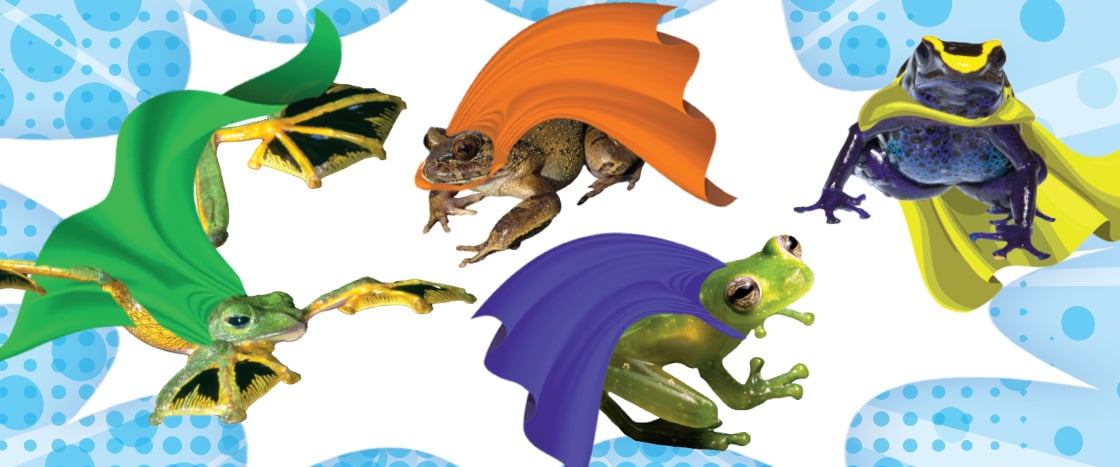Frogs live in many environments, from treetops to muddy rivers. As amphibians, most frogs begin their lives in water. These cold-blooded animals go through many changes as they grow and develop.

Meet the Superhero Frogs!
These frogs have adaptations that seem straight out of a comic book!
Learning Objective: Students will describe key traits of frogs and evaluate how unique adaptations help different frogs survive.
Glass Frog
Superhero power: Invisibility
Pete Oxford/Minden Pictures
Alex Hyde/NaturePL.com
The Glass Frog
What if you could see your heart, lungs, and stomach straight through your skin? You could if you were a glass frog! It has skin on its belly that’s almost as see-through as glass. This skin keeps it hidden from predators, such as lizards and birds, in the rainforests in Central and South America.
During the day, glass frogs sleep on the undersides of leaves. The frogs have green backs to help them blend in. Sunlight can pass through both the leaves and the frogs’ skin. When predators look at the leaves from above, they see a blurry outline and not a dark shape. To them, the object doesn’t look like a tasty frog, so they don’t attack. Danger avoided!
Poison Frog
Superhero power: Toxic Skin
iStockPhoto/Getty Images
MYN/JP Lawrence/NaturePL.com
The Poison Frog
This frog’s bright color communicates a message: Don’t eat me! I’m toxic!
Poison frogs that live in Central America and on the African island of Madagascar have to watch out for predators like birds and snakes. When a snake bites into one of these frogs, poisonous substances called toxins enter the snake’s bloodstream. They cause the snake to uncontrollably shake, so that it drops the frog like a hot potato! Some frogs produce enough poison to kill a snake.
Poison frogs get their poison from eating ants and mites, which get their poison from consuming toxic plants.
Wolverine Frog
Superhero power: Hidden Claws
Paul Starosta/Getty Images
Some African frogs have clawlike bones hidden inside their back toes.
Karl H. Switak/Science Source
The wolverine frog has a weapon inside its toes: sharp clawlike bones! When the frog is threatened by a predator, the “claws” rip through the skin, stabbing the attacker so it drops the frog. Over time, the claws pull back into the frog’s toes and the skin heals. Ten other African frogs have this ability too.
The wolverine frog has another name—the hairy frog. And it’s easy to see why! It’s covered in hairlike strips of skin. The frog lives in rivers in Central Africa that have little oxygen. The extra skin strips help the frog take in enough oxygen from the water to survive.
Gliding Frog
Superhero power: Built-in Parachute
Stephen Dalton/NaturePL.com (Gliding Frog); Tim Laman/NaturePL.com (Webbing)
Gliding frogs spread their limbs when they jump. Air pushes up against the webbing, slowing their fall.
Stephen Dalton/NaturePL.com
It’s a bird! It’s a plane! Actually, it’s a gliding frog! These frogs live high up in the tropical rainforests of Southeast Asia. If they encounter a predator like a snake in the treetops, the frogs have a special strategy to escape. Crawling down the tree would take too long. So instead, they jump—and glide through the air!
Gliding frogs have webbing, or thin skin, between their fingers and toes—and sometimes on the sides of their bodies too. When the frogs leap, they spread their arms, legs, and webbed feet wide. The webbing acts like a parachute, slowing the frogs’ fall. The frogs can travel up to 50 feet (15 meters) before landing on the ground.
1. PREPARE TO READ (10 minutes)
Use information from a video about frogs to define related vocabulary.
- Display these vocabulary words: amphibian and metamorphosis. Ask students to gather information about the words as they watch the video “It’s a Frog!” Afterward, have students share what they learned and work together to define each word. Then allow them to share with a partner the most interesting thing they learned from the video.
2. READ AND Compare (30 minutes)
Describe, evaluate, and compare frog adaptations.
- Share the article and allow students a minute to preview the photos. Read and discuss the descriptions of the four frogs. Write the names of the frogs on four sticky notes and post one on each of your walls. Have students move to the appropriate area to show their vote for each of the following questions: 1) Which frogs’ adaptations seem most unusual or surprising? 2) Which frogs’ adaptations seem most helpful to the frogs’ survival? 3) Which frogs’ adaptations would you most like to have as a superpower?
- Preview the Frog Adaptation Notes activity and work on the first example as a class if needed. Have student pairs complete the activity. Reconvene to discuss their answers, focusing on how adaptations help each frog survive.
3. RESPOND TO READING (20 minutes)
Estimate large numbers of items using several methods.
